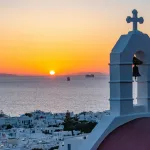Tinos appeals to a wide range of visitors because it offers a unique combination of religious significance, cultural heritage and natural beauty. An island known for hosting a variety of cultural events and festivals throughout the year, including music festivals, art exhibitions, and traditional festivities.
Location
Tinos is situated in the Aegean Sea and is the third largest island in the Cyclades archipelago. It remains an undiscovered location and attracts adventurers who wish to explore its fascinating geological formations, traditional villages, marble quarries, renowned cuisine, and ancient hiking trails. The island boasts unparalleled craftsmanship and is covered with kilometers of dry stone walls, all of which contribute to its reputation as the hand-made island.
Culture
The Church of Panagia Evangelistria, also known as the Church of Our Lady of Tinos, is a significant pilgrimage site for Greek Orthodox Christians and is well-known on the island. Every year, on August 15th, thousands of pilgrims flock to Tinos to partake in religious celebrations.
This gorgeous island features numerous traditional villages with Cycladic architecture, narrow alleys, and charming squares, showcasing its rich cultural heritage. Additionally, the Marble Art Museum in Pyrgos highlights the island’s marble-working tradition and the high-quality marble products produced by its craftsmen.
Cuisine
Tinos is known for its delectable local cuisine, which includes a variety of fresh seafood, traditional Greek dishes, and locally produced specialties such as artichokes, capers, and the famous “Tinian thyme honey.”
Hiking in Tinos
The island is hospitable and impressive throughout the year, which makes it ideal for a hiking family vacation. There are numerous picturesque villages in the interior, such as Voláx, Koumáros, Krókos, Kómi, Ktikádos, Agápi, Tarampádos, Falatádos, Triantáros, and more. Interestingly, there are 60 villages scattered all over the interior of the island. Some villages, like Koumáros and Agápi, have striking arched passages (kamáres), while others, such as Tarampádos, are notable for their large number of skillfully decorated pigeon houses. The area around Falatádos and Myrsíni boasts a unique landscape with many large boulders. The plateau of Xóbourgo, with its old fortress at an altitude of 559 meters, and the highly situated monastery of Kechrovoúni, near the village of Stení, offer exceptional panoramic views of the island. Finally, between Chóra and the bay of Kiónia, you can find the remains of the temple of Poseídoon and Amfitríte.






